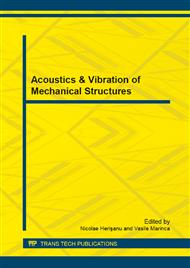[1]
J. Kanai, Semi-empirical formula for the seismic characteristics of the ground, University of Tokyo, Bulletin of the Earthquake Research Institute, 35 (1957) 309-325.
Google Scholar
[2]
H. Tajimi, A statistical method of determining the maximum response of a building structure during an earthquake, in 2nd World Conf. on Earthquake Engineering., Tokyo and Kyoto, Japan (1960).
Google Scholar
[3]
J. L Luco, H.L. Wong, Response of a rigid foundation to a spatially random ground motion, Earthquake Engineering and Structural Dynamics, 14 (1986) 891-908.
DOI: 10.1002/eqe.4290140606
Google Scholar
[4]
A. Zerva, Spatial Variation of Seismic Ground Motions-Modeling and Engineering Applications, CRC Press, Taylor&Francis Group, (2009).
Google Scholar
[5]
H. Sandi, On the seismic input for the analysis of irregular structures, Proc. IASS Annual Symp. IASS 2005 – Theory, Technique, Valuation, Maintenance, Bucharest, September (2005).
Google Scholar
[6]
H. Sandi, Random vibrations in some structural engineering problems, Studies in Applied Mechanics 14, Random Vibration – Status and Recent Developments, Elsevier, (1986).
DOI: 10.1016/b978-0-444-42665-9.50027-x
Google Scholar
[7]
H. Sandi, Considerations on the updating of earthquake resistant design codes, Proc. 10th International Conf. on Structural Safety and Reliability, ICOSSAR 2009. Osaka, Sept. 2009, Balkema.
Google Scholar
[8]
P. MURZEA, ASPECTE METODOLOGICE PRIVIND DETERMINAREA PE BAZĂ EXPERIMENTALĂ A MODURILOR PROPRII DE VIBRAȚIE ALE PAVILIONULUI EXPOZIȚIONAL CENTRAL ROMEXPO, TECHNICAL UNIVERSITY OF CIVIL ENGINEERING, BULETIN STIINTIFIC UTCB, 2, (2012).
Google Scholar
[9]
H. Sandi, M. Stancu, O. Stancu, I.S. Borcia, A biography of a large-span structure, pre- and post- earthquake, after the provisional and final strengthening. Proc. 8-th European Conf. on Earthquake Engineering, Lisbon, (1986).
Google Scholar
[10]
I. Takewaki, Critical Excitation Methods in Earthquake Engineering, Elsevier, (2007).
Google Scholar
[11]
H. Sandi, Stochastic models of spatial ground motions. Proc. 7-th European Conf. on Earthquake Engineering, Athens, (1982).
Google Scholar
[12]
Murzea, P., Vlad, M., - A study on the non-synchronous character of the seismic motion in the case of the Central Exhibition Pavilion Romexpo using experimental data, Technical University of Civil Engineering, Scientific Journal, Mathematical Modelling in Civil Engineering, 4, (2012).
Google Scholar


